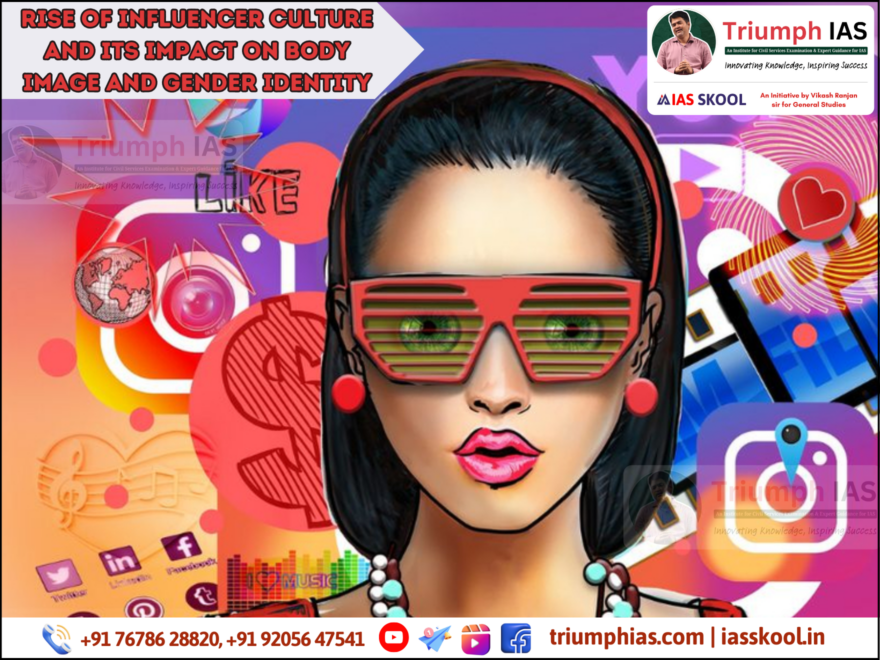Rise of Influencer Culture and Its Impact on Body Image and Gender Identity
(Relevant for Paper 1– Sociological thinker: Mead -Self and identity, Stratification and Mobility: Dimensions- Gender, Social Change in Modern Society: Agents of Social and Change and Paper 2– Social Change in India: Challenges of Social Transformation)
IntroductionIn the age of digital capitalism and hyper-connectivity, influencer culture has emerged as a powerful force shaping public consciousness, particularly on platforms like Instagram, YouTube, and TikTok. The representation of body image and gender identity by influencers deeply affects how individuals, especially youth, perceive themselves and others. They are the new spaces where body image ideals, gender performance, and self-identity are continuously reconstructed. This shift has critical implications for sociological discourse, especially within the frameworks of media and society, gender and stratification, and socialization — key themes in the Sociology syllabus. What is Influencer Culture?Influencer culture refers to the phenomenon where individuals with large social media followings shape public opinion, lifestyle choices, and social norms. These influencers often become agents of socialization, creating idealized lifestyles and aesthetics. Sociological Analysis of Influencer Culture
Example: A teenager constantly engaging with fitness influencers may begin to equate worth with slimness or muscularity, leading to body dissatisfaction.
Naomi Wolf’s “The Beauty Myth” is relevant here. She argues that media-controlled beauty standards are a form of social control over women. Pierre Bourdieu’s concept of “Cultural Capital” helps explain how influencers with “ideal” bodies are rewarded with popularity, creating a hierarchy of visibility.
Influencers who identify as non-binary or Trans are reshaping conversations on gender norms, promoting inclusivity, yet also facing backlash and trolling.
Gender Identity and PerformativitySocial media allows for the expression of gender non-conformity, yet paradoxically, it also promotes gendered stereotypes through visual content. Influencer marketing often exaggerates hyper-masculinity and hyper-femininity, reinforcing consumerist notions of gender. Influencers also challenge and reinforce gender roles. Many female influencers perform traditional femininity—grace, beauty, passivity—while male influencers promote hyper-masculinity or emerging identities like metrosexuality. But there is also a counter-trend: LGBTQ+ influencers disrupting hegemonic gender norms, opening space for non-binary and queer identities. This aligns with Judith Butler’s theory of gender performativity—gender is not what we are, but what we do. Yet, even here, commercialization of queer identities often dilutes radical critique, making it palatable for mainstream consumption—what sociologists call co-optation. Implications for Indian SocietyIn India, influencer culture intersects with caste, class, and regional disparities. Most top influencers come from urban upper-middle-class backgrounds, promoting a Sanskritized modernity. This marginalizes vernacular cultures and Dalit-Bahujan expressions, reinforcing symbolic violence as per Bourdieu. Influencers shape consumption patterns, making luxury lifestyles aspirational, yet inaccessible to many. This fuels relative deprivation and deepens social inequality. Way ForwardIndia’s youth are particularly vulnerable due to increasing smartphone penetration. There’s a need for:
ConclusionThe influencer culture is a double-edged sword. While it democratizes expression and challenges rigid norms, it also reinforces new forms of conformity to toxic beauty ideals, body control, and commodification of identity. While it opens up avenues for self-expression and gender fluidity, it also contributes to body anxiety. PYQsPaper 1
Paper 2
|


One comment